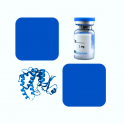
- Remove this product from my favorite's list.
- Add this product to my list of favorites.
Products
Newsletter
 |  |  |  |  |  |

Background
Hepatocyte growth factor receptor (HGFR) is also known as mesenchymal-epithelial transition factor (MET), c-Met, and is a glycosylated receptor tyrosine kinase that plays a central role in epithelial morphogenesis and cancer development. HGFR protein possesses tyrosine-kinase activity. The primary single chain precursor protein is post-translationally cleaved to produce the alpha and beta subunits, which are disulfide linked to form the mature receptor. HGFR is normally expressed by cells of epithelial origin, while expression of HGF is restricted to cells of mesenchymal origin. Upon HGF stimulation, HGFR induces several biological responses that collectively give rise to a program known as invasive growth. Abnormal HGFR activation in cancer correlates with poor prognosis, where aberrantly active HGFR triggers tumor growth, formation of new blood vessels (angiogenesis) that supply the tumor with nutrients, and cancer spread to other organs (metastasis). HGFR is deregulated in many types of human malignancies, including cancers of kidney, liver, stomach, breast, and brain. Normally, only stem cells and progenitor cells express HGFR, However, cancer stem cells are thought to hijack the ability of normal stem cells to express HGFR, and thus become the cause of cancer persistence and spread to other sites in the body. Various mutations in the HGFR gene are associated with papillary renal carcinoma. HGFR mediates a complex program known as invasive growth. Activation of HGFR triggers mitogenesis, and morphogenesis.
Source
Recombinant Biotinylated Human HGF R, Avitag,His Tag (MET-H82E1) is expressed from human 293 cells (HEK293). It contains AA Glu 25 - Thr 932 (Accession # P08581-1).
Predicted N-terminus: Glu 25 (α chain) & Ser 308 (β chain)
Molecular Characterization
This protein carries a polyhistidine tag at the C-terminus, followed by an Avi tag (Avitag™).
The protein has a calculated MW of 32.5 kDa (α chain) & 72.7 kDa (β chain). The protein migrates as 40-50 kDa (α subunit) and 90-100 kDa (β subunit) under reducing (R) condition (SDS-PAGE) due to glycosylation.
Biotinylation
Biotinylation of this product is performed using Avitag™ technology. Briefly, the single lysine residue in the Avitag is enzymatically labeled with biotin.
Biotin:Protein Ratio
Passed as determined by the HABA assay / binding ELISA.
Endotoxin
Less than 1.0 EU per μg by the LAL method.
Purity
>90% as determined by SDS-PAGE.
Formulation
Lyophilized from 0.22 μm filtered solution in PBS, pH7.4 with trehalose as protectant.
Reconstitution
Please see Certificate of Analysis for specific instructions.
For best performance, we strongly recommend you to follow the reconstitution protocol provided in the CoA.
Storage
For long term storage, the product should be stored at lyophilized state at -20°C or lower.
Please avoid repeated freeze-thaw cycles.
This product is stable after storage at:
-20°C to -70°C for 12 months in lyophilized state;
-70°C for 3 months under sterile conditions after reconstitution.
Bioactivity
Please refer to product data sheet.
(1) "Lidocaine attenuates TMZ resistance and inhibits cell migration by modulating the MET pathway in glioblastoma cells"
Chen, Chong, Huang et al
Oncol Rep (2024) 51 (5)
(2) "Fosgonimeton attenuates amyloid-beta toxicity in preclinical models of Alzheimer's disease"
Reda, Setti, Berthiaume et al
Neurotherapeutics (2024)
(3) "Halimane Derivatives from Plectranthus ornatus Codd. as Novel Anti-cancer Agents"
Bangay, Brauning, Kowalczyk et al
Biomed Pharmacother (2024) 174, 116516
Showing 1-3 of 777 papers.
Citations
"Fabs-in-tandem immunoglobulin is a novel and versatile bispecific design for engaging multiple therapeutic targets"
Authors: Shiyong Gong, et al.
Journal: Mabs 2017
Application: Cell surface dual binding assay by FACS
Follow us